The Chinese Compass: description, composition, origin and applications to harmonize and furnish homes with Feng Shui in balance with the cosmos.
The Chinese Compass is a geomantic compass called ‘Lo Pan’: ‘Lo’ means “anything” and ‘Pan’ means “cup”. In fact, the ‘Lo Pan’ is a circular cup that contains all the mysteries of the earth. It is used to determine the orientation of a site, which provides the basis for the calculation of the geomantic map. The geomantic compass is composed of 36 rings and 24 directions. Each ring serves to determine a specific aspect of Feng Shui.
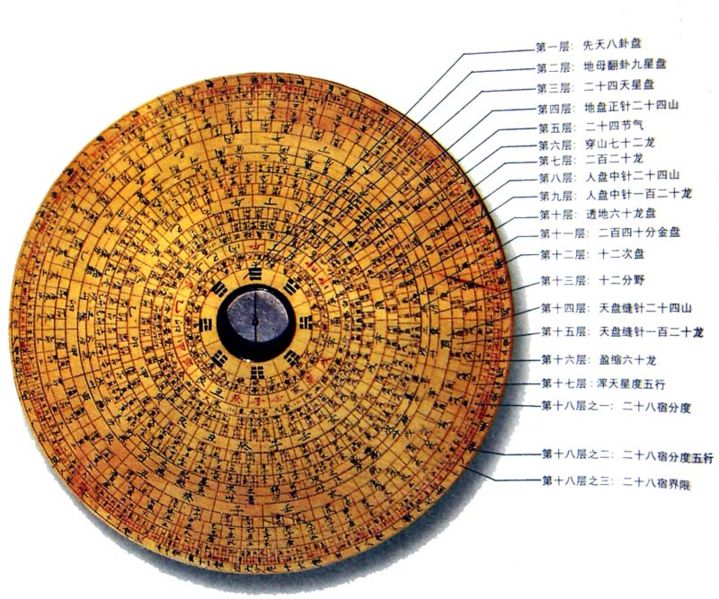
The Chinese Compass or Geomantic Compass – Image by By Pcae18 at the English Wikipedia, CC BY-SA 3.0, by Commons Wikipedia
The Chinese Compass or geomantic compass is not only a tool to obtain information related to a Feng Shui reading. It also contains knowledge of the structure of the universe. This knowledge is encoded in three important rings in the compass; The Circle of 24 Directions, the Anterior Heaven Circle, and the Later Heaven Circle.
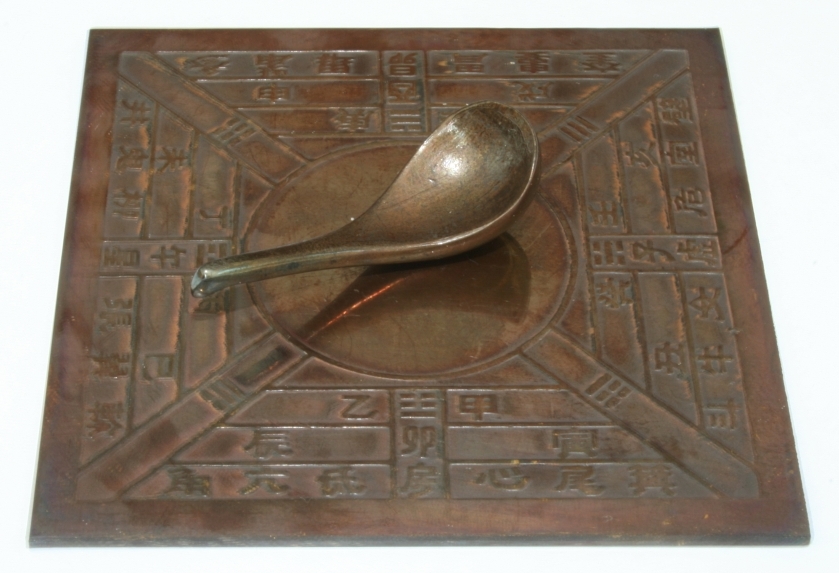
The Chinese Compass: Ancient example of Si Nan from the Han Dynasty – Image License: CC BY-SA 3.0, By Commons Wikipedia
The Circle of 24 Directions describes the realm of the Earth and the energy flowing within it. It is the world of mountains, lakes, valleys, rivers, wind, trees, roads, and other physical aspects that make up the immediate reality in which we live.
In this realm, energy can be directed, dispersed, augmented, and collected. The Anterior Heaven Circle describes the realm of the fundamental presence of the Tao, the principles or laws of unchanging existence. Formless and timeless, energy in this realm surrounds everything, animate and inanimate things. This intrinsic energy can be tapped and used to influence the flow of energy in the land.
The Later Heaven Circle is the realm of the flow of things. In this realm, energy changes with time and space but cannot be directed or used. Rather, it can be interacted with or avoided, as if it were a visitor, once the means to do so have been obtained.
THE CIRCLE OF 24 DIRECTIONS
The Circle of 24 Directions is sometimes called the Mountain Circle. It is used to determine where the flow of the earth’s energy enters a particular location. A Feng Shui reading begins with calculating the front and back directions of a site. In Lo Pan, each of the eight directions of the compass is divided into three parts for a total of 24 directions. Each division is in turn associated with both yin and yang.
The direction of a location is designated by a pair of names. The first name indicates the back, the second one the front. In Feng Shui terminology, they are called the Mountain Direction and the Front Direction, respectively. If the first is identified, you consequently know the second.
Energy entering from the front has a greater influence than energy entering from the back. Energy entering a building can be beneficial, malefic or neutral depending on the direction of the entrance.
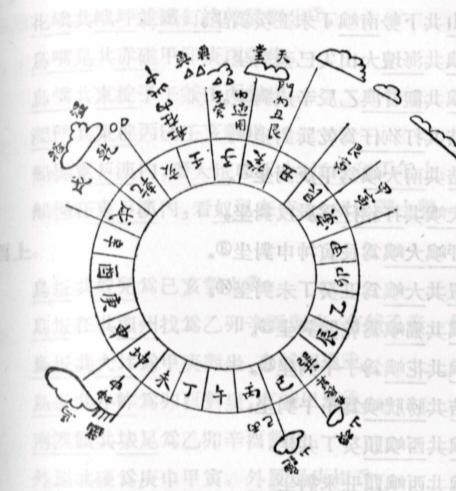
The Chinese Compass: Mariner’s diagram of reading the rings – Image By Unknown author – Unknown source, Public Domain , By Commons Wikipedia
THE CIRCLE OF THE FRONT HEAVEN
The Circle of the Front Heaven is called Ho Tu or Ba Gua of the Eight Directions. The Ba Gua of the Front Heaven describes the order of the universe. The Ba Gua determines good fortune or bad fortune, and good fortune or bad fortune determines the success or failure of great efforts. In the Ba Gua of the Front Heaven, Qiàn (heaven) is located in the south, Kun (earth) in the north, Li (fire) in the east, and Kan (water) in the west. Zhen (thunder) is in the northeast, Gen (mountain) is in the northwest, Dui (lake) in the southeast, and Xun (wind) in the southwest.
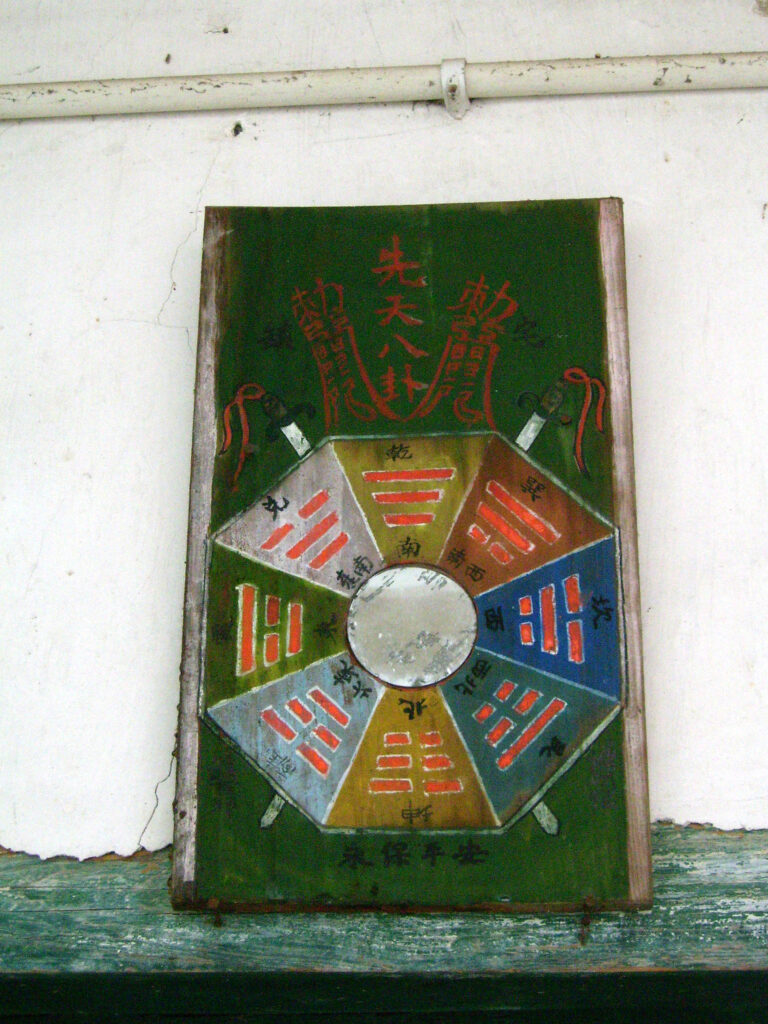
Arrangement of the Trigrams in the Sequence of the Fore Heaven on original reproduction – licensed according to CC BY-SA 3.0, Wikimedia Commons
THE CIRCLE OF THE POSTERIOR HEAVEN
The Circle of the Later Heaven is the Lo Shu which is made up of the eight directions of the Ba Gua of the Later Heaven. While the Ba Gua of the Fore Heaven represents the fundamental permanence, the Later Heaven represents change and movement. In the Ba Gua of the Later Heaven, Li (fire) and not Qian (heaven) is in the south. Clockwise from Li (fire), Kun (earth) is in the southwest, Dui (lake) in the west, Qian (heaven) in the northwest, Kan (water) in the north, Gen (mountain) in the northeast, Zhen (thunder) in the east, and Xun (wind) in the southeast.
In the Ba Gua of the Later Heaven, each trigram is associated with a number and a color. Thus Kan (water) is 1-white, Kun (earth) is 2-black, Zhen (thunder) is 3-jade, Xun (wind) is 4-green, Qian (sky) is 6-white, Dui (lake) is 7-red, Gen (mountain) is 8-white, and Li (fire) is 9-purple. With the addition of the 5-yellow Center to the 8 directions, the Ba Gua is now expanded to nine positions. These constitute the Nine Palaces discussed in detail in the next chapter.
The movement of the Ba Gua of the Later Heaven in the Nine Palaces is the key to understanding how and why Lo Shu, not Ho Tu, is the vehicle of divination. With the Nine Palaces, the trigrams are no longer tied to one direction. Their position will move according to the year, month and the Nine Cycles. It is the movement of the trigrams in the Nine Palaces that reveals the cycle of changes, allowing us to observe the changes of energy that flows through the universe.
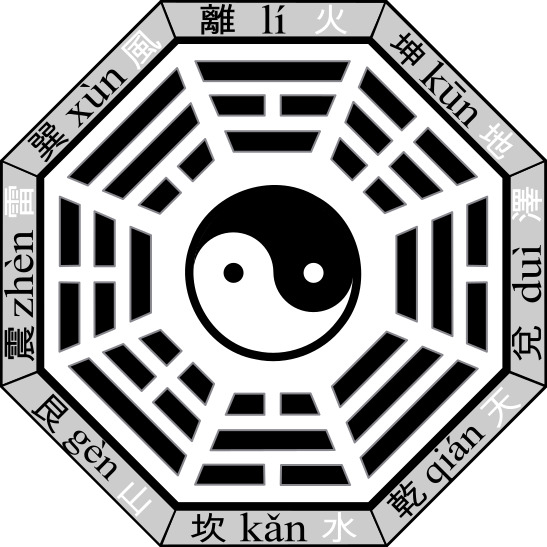
Ba Gua of the Eight Directions according to the Later Heaven sequence – Image by Benoît Stella alias BenduKiwi, CC BY-SA 3.0 by Wikimedia Commons
THE NINE PALACES
The flow of forces, both beneficent and maleficent, is revealed in the movements of the Ba Gua through the Nine Palaces. The Nine Palaces are the 8 directions of the Chinese Compass plus the center. The eight positions are filled by the eight trigrams. Each palace is identified by a pair of colors/numbers, also called a “star”.
THE NINE STAR QI
The Nine Star Qi is a system of archetypes, of energetic symbols that are repeated everywhere and apply to every phenomenon. Like any other divinatory or astrological system, the Nine Star Qi originates from the energies of the cosmos. As our planet rotates around the sun, we find ourselves within a massive current of energy that pours from the infinite universe to support our galaxy, the Milky Way. Since the magnetic bands that surround the earth are quite “open” above the polar regions, these areas are most directly influenced by the flow of this current. The North Pole, facing directly one of the brightest branch of our galaxy, receives the strongest energy of this charge penetrating into our planet. Among all the celestial forces that shape our destiny, the forces coming from the North Pole constellations have traditionally been considered crucial and of primary importance, and have also been routinely used in navigation as practical landmarks in the sky.
High above the North Pole, the massive energies of the cosmos are captured and directed downward by the various stars in a coarser, more material form. These energies are then converged as currents into our solar system, where they are again collected and further condensed by the planets, according to specific patterns, to enter the earth’s atmosphere, where they finally configure themselves in the ways described by the Nine Star Qi.
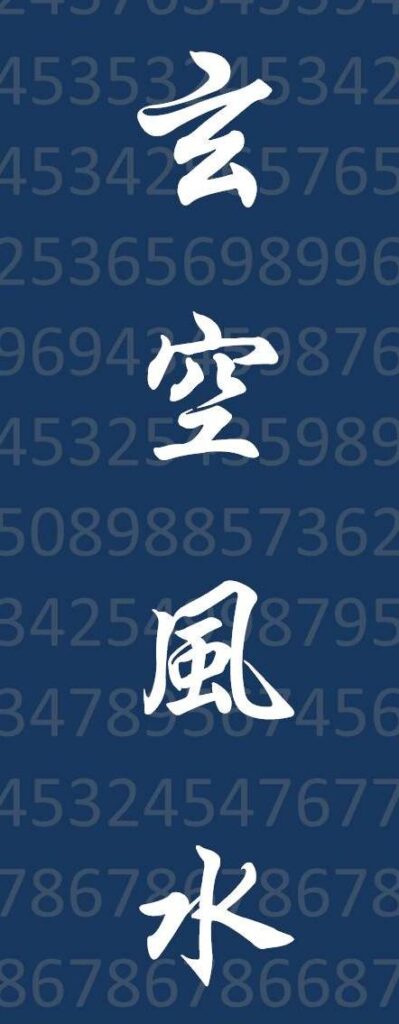
Example of Flying Stars Feng Shui or 9 Star Qi – image by K3anlim, CC BY 3.0 via Wikimedia Commons
The nine stars that play the most decisive role in this process of transformation and condensation are:
the Pole Star (or North Star)
Vega (a star in the constellation Lyra)
the seven stars in the constellation Ursa Major
When this enormous current of energy invades the vicinity of our galaxy, it is polarized by the first two of these stars, which act in a certain sense as the positive and negative poles of this enormous stellar “battery”. Vega, acting as the negative pole, is associated with cold, winter, the moon and lunar forces, the passive yin energy, and the image of Water. The Pole Star, the positive pole, is associated with heat, summer, the sun and solar energies, the active yang energies, and the image of Fire. The seven stars of the Big Dipper, the body of this battery, act as a modulator and frequency amplifier. These stars balance the spark between the two stellar “poles,” generating a variety of influences in the universal Qi current as it rushes toward the Earth.
In ancient times, the Pole Star was called the storehouse or vault of heaven to express its role as a celestial catalyst. Each of the other stars was also classified to reflect its function within this system. The tail or “handle” of the Big Dipper rotates annually around the central hub, the Pole Star, and has been regarded as a celestial compass as it turns into different directions each season: north in winter, east in spring, south in summer, west in autumn. This is the origin of the seasonal and directional archetypes of the Nine Star Qi, which were classified in the Yi Jing literature as the Later Heaven Sequence. This pattern is also expressed with a Magic Square, the sum of whose numbers always gives 15, which is actually represented as an octagon and forms the basis of the Ba Gua.
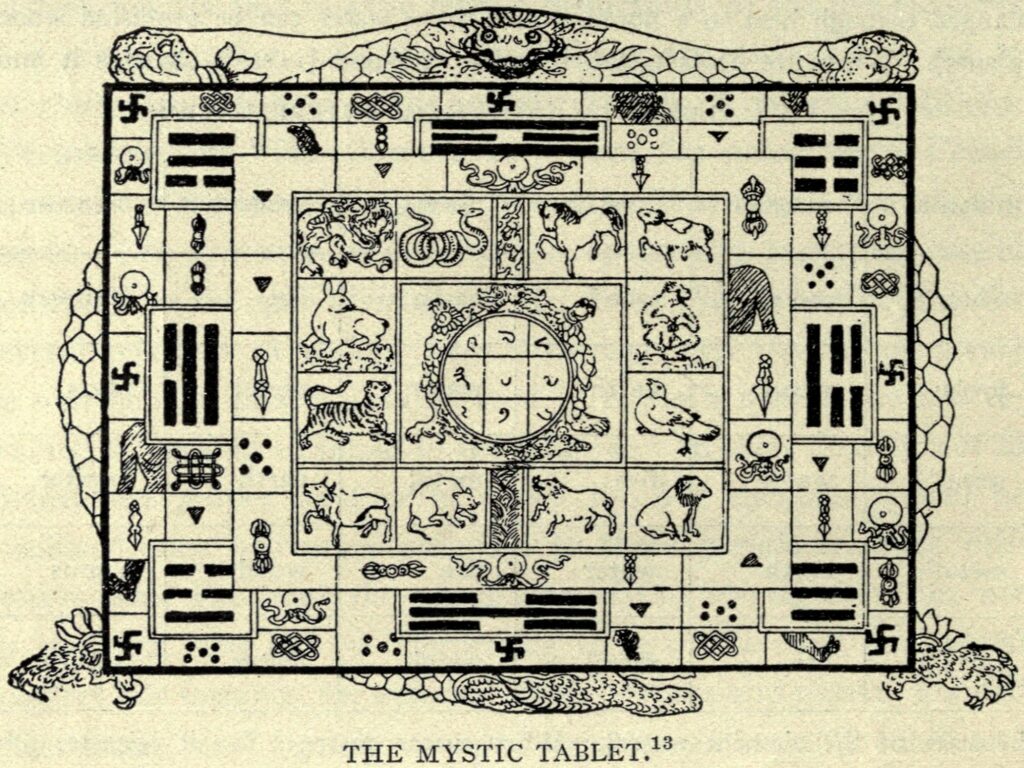
Tibetan Magic Square The Shu (Turtle) in the center with astrological correspondences and sequence of trigrams according to the geographical directions of the Ba Gua – Image by An unknown Tibetan artist, Public domain, via Wikimedia Commons
THE NINE NUMBERS
The five odd numbers in this diagram refer to the five planets closest to the earth. These particular numbers and the directions and seasons, which they represent, have a special relationship with these planets.
Each planet receives a bundle of energy current from the external celestial forces mentioned above; these bundles are then collected, directed downwards and transmitted by these specific planets and correspond to the five odd numbers. Each of these also has a corresponding complementary number, an even number that is more yin, which modifies the more pronounced influences of the odd (more yang) numbers: 8 is connected to 1 (Mercury), 4 to 3 (Jupiter), 2 to 9 (Mars), 6 to 7 (Venus). The number 5, being located in the center of the square, has no complementary. 5 represents Saturn, which is considered the central planet that coordinates the celestial energies and transmits them to the earth. The Five appears as the hub of the system, the central receiver, the catalyst, balancer and distributor of all energies.
THE CHINESE COMPASS AND ITS APPLICATION ACCORDING TO THE BLACK HATS METHOD
The simplest application of the system is implemented using the Ba Gua of the Later Heaven with all its azimuthal, numerological and energetic information to which are added nine colors, nine parts of the body and nine life situations.